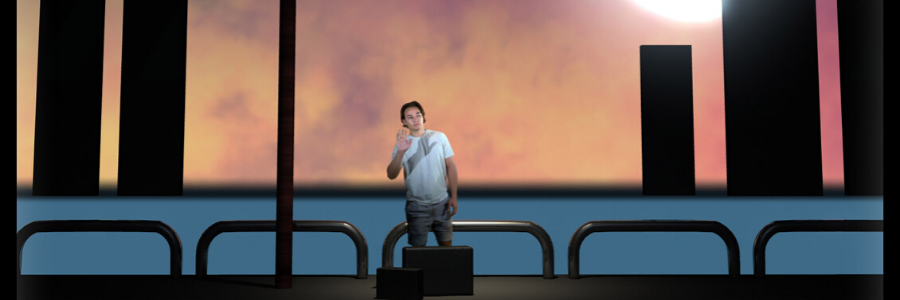TTF Lecturer Creates Virtual Theatre Experience
Sam Shpigelman is working with the latest cutting-edge technology in virtual reality to mimic a full stage theatre production

by Cristian Alvarez and Georgia Burgé
July 14, 2020
July 14, 2020
The world of performing arts is one of many industries hit hard by the coronavirus pandemic. Ongoing projects and productions suddenly came to a halt as theatres and studios were closed down.
Amidst these challenging times, Sam Shpigelman, a lecturer in San Diego State University’s School of Theatre, Television, and Film, found a way to readjust to this new normal by using cutting edge technologies to bring shows to life in a digital format.
SDSU’s School of Theatre, Television, and Film is currently in the process of developing a new bachelor’s degree program focusing on new media production, including topics such as 3D animation and visualization, virtual reality, and gaming. In developing this program, Shpigelman saw the potential of these technologies to facilitate virtual performances in this time of social distancing.
Shpigelman has found that there are a few different ways to bring performances to life without ever having an actor set foot on a physical stage. The first is by using a green screen. Actors can record themselves delivering their performance in front of a green screen in their homes. The footage of their performance can then be placed onto an entirely computer-generated stage, complete with other actors and set pieces. The only limitation for the actors is that their performance space is confined by the size of their green screen.
The second method that Shpigelman is exploring is the use of motion capture technology to create digital avatars that mimic actors’ movements on stage. Actors would don a motion capture suit that could track their movements and gestures as they deliver their performance. That information would then be used to drive the performance of a digital avatar of the actor that could move around the computer-generated stage. Unlike the green screen approach, this technique does not confine actors to a set performance space so they can move freely while delivering their performances.
Shpigelman said the capabilities this technology offers could be of great public interest since people do not have access to performing art centers for the time being. The virtual experience is not only an alternative to live performance but an opportunity to invite more people to interact with the virtual art it creates and may pave the way for future technologies and art forms.
“The industry is going in that direction anyway, but it doesn’t necessarily mean the virtual art is going to replace real art in the long run,” Shpigelman said. “I am positive that live performing arts will always be there because people want to see and be involved in live events.”
In addition to making performances more accessible to audiences, these digitized performances allow more freedom in terms of set design. A set piece that would normally take several hours and hundreds of dollars to build can be inserted into a scene with a few clicks. Intricate costumes and makeup can be placed on the digital actors in seconds.
“We can create action scenes without putting our actors into danger, build visual effects in virtual environments that don’t have to get approved by a fire marshal, and overall, achieve things that cannot be done easily in the real world,” Shpigelman said.
Shpigelman is currently working with TTF Professor Randy Reinholz on an experimental piece that will utilize both green screen and motion capture technologies.
The content within this article has been edited by Lizbeth Persons.
More PSFA Stories